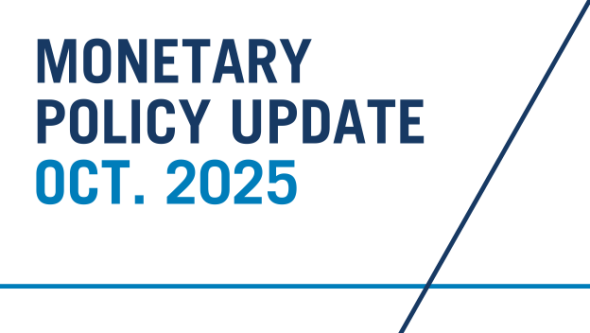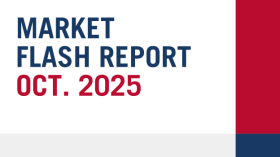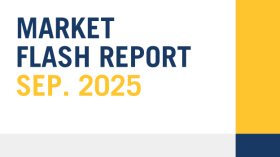
Monetary Policy Update: October 2025

As largely expected, the Federal Reserve announced that it would cut its short-term policy rate by 25 basis points, targeting a new rate of 3.75% to 4%. This is the second consecutive cut in as many meetings.
Yesterday’s cut confirms the Fed remains focused on boosting the stagnant labor market, with a focus on preventing a surge in unemployment while acknowledging that inflation remains stubborn and may increase in the near term. The Fed also announced it would end its quantitative tightening cycle on Dec. 1, a move that had also been increasingly seen as likely. They will reinvest proceeds from maturing MBS holdings into Treasury securities, as money markets indicate they have reached an appropriate level of reserves in the system. As a reminder, the Fed had slowed the pace of its balance sheet run-off earlier this year.
How did the markets respond to the news?
Equity markets took the announcement in stride for the most part. The S&P 500 closed flat on the day, the Dow fell slightly and the Nasdaq closed solidly in the green. Small caps took the biggest hit, however, as the Russell 2000 index closed well off its intraday highs, falling 0.9% on the day overall.
The U.S. Treasury curve steepened slightly overall as the 1-month and 1-year yields fell, while other parts of the curve moved higher. The 10-year yields moved back above 4%, as a December rate cut that the market had been anticipating no longer looks certain.
What is the Fed's "forward guidance"?
When questioned about a December cut, the Fed was direct in its comments, stating that a further reduction of the policy rate at the next meeting was not a foregone conclusion. This is a change from comments in its last meeting, when the Committee projected a 25 bps cut at each of the meetings through the end of the year. Differing views among members on how to proceed in the weeks and months ahead are starting to emerge.
The FOMC monitors the overall financial system and its ability to sustain shocks. The Committee acknowledges that some households are under stress, but banks are well capitalized and there’s not much leverage in the system. The unemployment rate remains low, yet job creation is also very low at the moment. Inflation is drifting back towards the Fed’s 2% goal but remains elevated.
While interest rates remain modestly restrictive, they’re meaningfully less tight than they were, which should help the labor market from getting worse. Tariffs may be boosting current inflation numbers, but the Committee maintains the belief that the impact of tariffs will be temporary.
The Fed has now cut a total of 150 basis points from recent policy benchmark highs.
What will the Fed be most focused on through the end of the year?
In the press conference, the Fed acknowledged it is facing a challenging situation with a weakening labor market and stubborn inflation, but indicators suggest the economy is expanding at a moderate pace. The continued government shutdown could warrant some caution when making a decision during its final meeting if it does not have all of the data typically available. However, enough data remains for the Fed to continue to monitor conditions, and a drastic decline is not materializing. Differing views from committee members about how to proceed with additional rate cuts moving forward are starting to become more distinct, which will likely continue as the policy rate nears its neutral rate. The fact remains that monetary policy will likely remain in restrictive territory, even if the Fed elects to cut by another 25 bps in December 2025.
As always, we will continue to keep you updated on monetary policy as facts and circumstances change.

